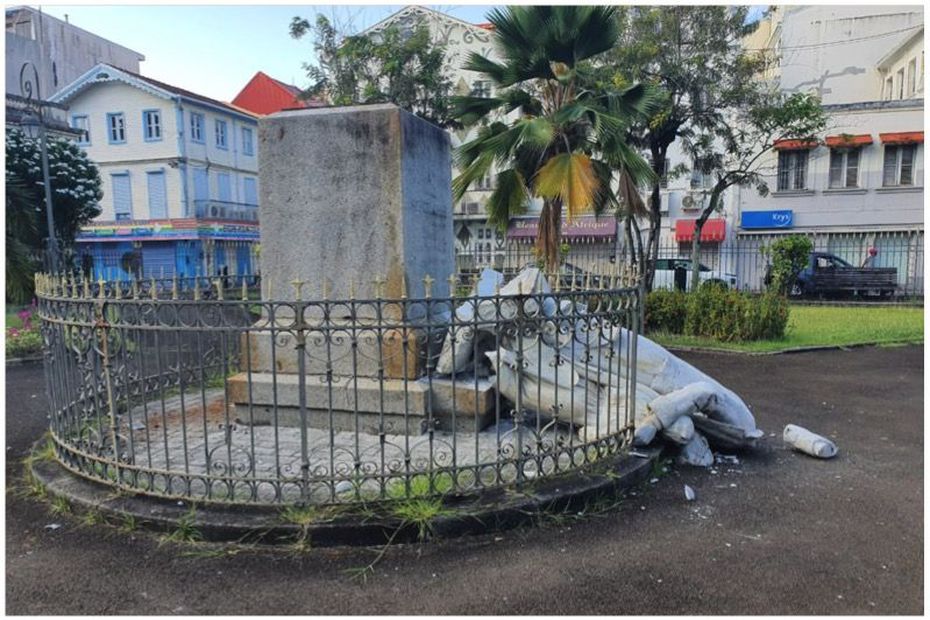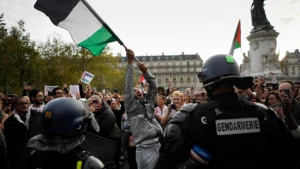Toppling statues of white men is just. They are the ones who envisioned, conceptualized, encouraged, organized, trafficked in, enslaved, colonized, and thus justified the deportation of Africans. They established slavery and turned people into “objects.” They authorized the exploitation, torture, and death of bodies and of resources. They turned the belly of the Black woman into capital, prohibited them from becoming families, imposed the Black Codes and the Native Codes. They robbed, pillaged, and destroyed cities, universities, and temples, all in the name of a “superior” civilization. Public spaces must be freed of their presence.
***
It should come as no surprise that the demand to take down statues in France immediately triggered the same old debate — one in which stonewalling is based on using “elements of language” that are part of a stale and rehashed discourse that combines bad faith, ignorance, and contempt. It is a defensive reaction, one that claims fidelity to “history” — to “both its dark pages as well as its pages of light.” But this reaction does a poor job of masking the fear that the entire scaffolding of lies and fictions will collapse, scaffolding upon which rests a mangled and mutilated national narrative. Taking down the statues of colonial criminals is a demand for memorial justice, dignity, respect, and equality. It is an important part of the broader struggle against structural and systemic racism.
As the old proverb goes, when the sage points at the moon, the fool looks at the finger. Thus, we do not confuse the dismantling of statues with an end to racial profiling, police violence, racism, sexism, inequality, and injustice. Nor are we confusing history with memory. The statues do not tell the stories; they are just the result of political choices that testify to what the powers that be value and the memory they want to stage. They are the result of decisions that impose on the public landscape a narrative, personalities, and aesthetics. None of it is neutral.
What is being demanded, in the political period in which we live, in this moment when in the face of a pandemic, government decisions have exacerbated racial inequalities and injustices, demonstrating the reality that some have been explicitly made more vulnerable to premature death, is respect and dignity. But removing statues is not just a symbolic act. It is an act of liberation, of opening up to the stories, memories, and representations that we need today.
This is something we must resolve. We can no longer allow the same people to assume the right to decide for us, and without us, what statues adorn our cities, what names are given to our streets, to our squares, and to our plazas. It is 2020, and it is time to reconsider the architecture of these cities that were made for wealthy and healthy white men, not to welcome with goodwill and generosity the vulnerable, the racialized, the homeless, the undocumented, refugees, migrants, workers, and Black people. The statues reflect the world the ancestors of those white men erected, a world that guarantees them the space to display their power and their arrogance. These are “their” cities — the cities of conquerors, of men who crushed the uprisings of the oppressed, who took cruel revenge on those who dared challenge their power, who went to the four corners of the world to smash, exploit, dispossess, rape, steal, and plunder so that their sons could be born with privileges that owed nothing to any talents or skills.
Now we claim our own right to live in these cities, to be able to decide collectively what surrounds us, to walk in the streets, the squares, the plazas, and the gardens without coming upon these representations of those who have defended a racist, sexist, xenophobic, and murderous ideology and who have sought to divide humanity between those with lives that count and those with lives that don’t count. We want to breathe.
The Actions That Matter, And the Actions That Don’t…
On May 22, 2020, in Fort-de-France, Martinique, a group of local youth toppled two statues of Victor Schoelcher.1Translator’s note: Schoelcher (1804–1893) was a journalist who visited the United States in 1829 and 1830 and began to write abolitionist tracts about slavery. He made later trips to the French slave colonies in the Caribbean. His advocacy of abolition aimed at reconstituting the production of sugar in large central factories rather than using enslaved people. Why May 22? Because on that day in 1848, the enslaved refused to wait for the arrival of the commissioner from the French Republic sent to implement decree of February 27 that abolished slavery. They declared themselves free. They saw no need to wait for freedom from an envoy from France. They knew the identity of their liberators. It was the Maroons,2Translator’s note: The Maroons were descendants of Africans in the Americas who escaped from slavery and formed settlements or joined settlements with Indigenous people, often fighting off efforts at colonization by whites. the rebels, the slaves who every day and every night resisted dehumanization.
This May 22, two young women took responsibility, in front of the cameras, for destroying the two Schoelcher statues. Quietly and firmly, they told the police, judges, and the state why they took action. “Schoelcher is not our savior,” proclaimed their manifesto, which also listed a series of demands. One of the young women was taken into custody and later released; the public prosecutor (a white Frenchman) announced an investigation and promised that the culprits would be punished. Condemnations of the action were immediate. In Martinique, they came from writers, intellectuals, historians, and elected officials. All the elements of language around history and colonial memories were present: accusations about the erasure of history and condemnations of youth who understand nothing about the writing of history. French President Emmanuel Macron strongly condemned the action, invoking the “greatness of France” and declaring that the act “sullies [Schoelcher’s] memory and that of the Republic.”
Shortly thereafter, in a conversation with one of the two young women, I learned that the group that toppled the statues was the same group that in November and December 2019 organized the blockade of shopping centers belonging to the Hayot family, a powerful capitalist conglomerate of békés3Translator’s note: This Creole term used in the French Antilles describes descendants of the French colonizers who settled on the islands. They are a small minority in the former colonies and typically control nearly the entire industrial and retail economies. called GBH that enjoys a virtual monopoly on distribution of goods from “overseas.” One of their companies, Laguarigue, headed by Yves Hayot, imported the pesticide chlordecone to Martinique, which poisoned the island, its rivers, lagoons, fields, and inhabitants.4GBH owns a wide array of stores — Carrefour, Euromarché, Mr. Bricolage, Renault, and Décathlon — across the Caribbean (in Martinique, Guadeloupe, Guyana, Cuba, Saint Lucia, Dominican Republic, Trinidad and Tobago), Indian Ocean nations (Reunion Island, Mauritius), metropolitan France, Africa (in Morocco, Algeria, Ghana, Ivory Coast), China, and New Caledonia. GBH is active in three segments: large retail shops, automotive distribution, and various industrial activities, including production of yogurt under the Dannon brand in Reunion Island and the production and export of rums (Rhum Clément and J.M. in Martinique). The prefect of Martinique branded these to be “unacceptable illegal blockades,” deployed the police in large numbers, and had seven activists arrested and charged (their trial has not yet taken place as of this writing).
I mention these facts from Martinique because their omission in the current debate on taking down statues raises questions. The toppling of the slave trader Edward Colston on June 7 in Bristol, England, has come to symbolize, in the eyes of the media, politicians, and even activists, the movement to bring down statues of men linked to slavery, colonization and imperialism, and therefore inevitably to racism — a movement that rapidly became global. Why is the May 22 action in Martinique so unknown? It is probably because there is a hierarchy of militant actions — those that count more and those that remain marginal. In France, the struggles “overseas” never echo as they should. They are seen neither as political acts nor as theoretical reflections that contribute to critical debates. This undoubtedly stems from an inability to think about the intertwining of anti-racist struggles in France and those in other countries, to think about the multiple spaces within which French colonialism and struggles play out.
The words of the youth in Martinique in 2019 and 2020 trace the contours of French colonialism in the 20th century and its neo-liberal reconfigurations, the exclusion of all racialized youth, and the weight that slavery and colonial status continue to have on the territory of the French republic. These young people proclaimed that “Black Lives Matter.” They explain what drives their militancy: opposition to poverty; the lack of future prospects (50% unemployment among young people for decades, a high migration rate); the poisoning of their country by political choice; the lack of reparations; blocked access to financial and social capital, health, and drinking water; structural and systemic racism; the dependence of the Martinique elite on French power. The scandal in Martinique is not the fall of Schoelcher’s statues; it is an infant mortality rate three times higher than in France, a prostate cancer rate among the highest in the world, and a youth to whom power continues to say “the future is elsewhere.” The argument that Schoelcherism5Translator’s note: In Martinique, what has come to be known as “Schoelcherism” is the idea of indebtedness to France as some generous benefactor country that granted freedom to the enslaved. It is reflected across the island in street names, a library, a high school, and an entire town — in addition to the two statues. is the problem and that we must “respect Schoelcher” because he “saved French honor,6Patrick Chamoiseau, Twitter, May 23, 2020. Translator’s note: Chamoiseau is a famous Martinique writer who concentrates his work on Creole culture. is based on an accounting approach to history, the page of good deeds longer than the page of bad ones. What is important here is why the Republican Schoelcher, like so many of his compatriots, defended colonization and saw the abolition of slavery as the starting point for French colonization. His complicity raises the question of the colonial republic. And even if these statues were erected and financed by freedmen, even if Aimé Césaire7Translator’s note: Aimé Césaire (1913–2008) was an author and politician from Martinique who helped found the “négritude” movement in Francophone literature. His essay Discourse on Colonialism, first published in 1950, is considered a foundational work of anticolonialism in which the author describes how the “civilizing mission” of European colonizers actually decivilized the colonized.” paid homage to the man (while saying that his work had been insufficient), it is 2020, and the people of Martinique have every right to want to move on to different representation of their memories and their history.
Schoelcher’s statues reinforce a story of the abolition of slavery that erases the incessant, long, difficult struggle of those who paid with their lives for their anti-slavery work: the enslaved on the plantations, the Maroons, and the Haitian revolutionaries. If Schoelcher belongs to the history of French abolitionism, he is only one element that brings into play all the ambiguity of French abolitionism. Above all, what I want to point out is where the movement of the toppling of statues began: from the country of Césaire, Édouard Glissant,8Translator’s note: Édouard Glissant (1928–2011) was a writer, poet, and philosopher from Martinique. Frantz Fanon,9Translator’s note: Frantz Fanon (1925–1961) was a psychiatrist, philosopher, pan-Africanist, and Marxist humanist from Martinique whose book The Wretched of the Earth, which is considered one of the most important texts on colonialism ever written, analyzes the dehumanizing effects of colonization on both individuals and nations. and today of the young women who are smashing the postcolonial consensus and bringing to light “two evils that plague Martinique society: on the one hand, its inertia in the face of a colonial heritage that still lives; on the other hand, the widening gap between an aging and middle-class society and its youth demanding social change.”10Isis Labeau-Caderia, “La Martinique, malade de sa colonialité et de sa structure gérontocratique” (“Martinique: Sick of its Coloniality and Gerontocratic Structure”), France-Antilles, May 28, 2020
Racism and Antiracism
In France, defensive reactions to the demand for the removal of statues testify to the place of structural racism, the colonial past, and the presence of coloniality in the construction of the French nation. According to an IFOP-Fiducial poll, 71% of French people are opposed to the removal of statues, while only 8% consider it “justified to rename streets or remove statues of all figures in French history deemed controversial.” Structural racism has been woven into the daily life of French society. It has been naturalized and, for the vast majority of French people, it has become part of the order of things — to the point where they simply didn’t have to think about it and could ignore its very existence. “France is not racist” has become a truism: only a few uneducated or extreme right-wing people could be racist. Statues of soldiers responsible for colonial crimes became a natural part of the landscape, like human zoos, like Tintin in the Congo,11Translator’s note: Tintin is a famous Belgian comic book character, first appearing in 1929. Tintin in the Congo, the second Tintin book, has the young journalist traveling to Congo — then a Belgian colony — where he uncovers a diamond smuggling ring led by American gangster Al Capone. In the story, Congolese people are portrayed as stupid and infantile. or like Tarzan. An emotional attachment was created, no matter who Colbert,12Translator’s note: Jean-Baptiste Colbert (1619–1683) was France’s First Minister of State under King Louis XIV. Gallieni,13Translator’s note: Joseph Gallieni (1849–1916) was a French military commander who spent most of his career administering various French colonies. Bugeaud,14Translator’s note: Thomas Robert Bugeaud (1784–1849) was the Governor-General of the French colony of Algeria. Faidherbe,15Translator’s note: Louis Faidherbe (1818–1889) was a French general and colonial administrator, primarily in the colony of Senegal. He waged the campaign to colonize most of the rest of West Africa. Mangin16Translator’s note: Charles Mangin (1866–1925) was a French general during World War I whose nickname was “the butcher.” really were. They became honorary members of the great French family; their statues became part of the familiar and everyday landscape; they served as landmarks in social and cultural life. Colbert imposed the Black Code; Bugeaud, from whom Gallieni drew his inspiration to colonize by massacring and practicing the scorched earth policy, is responsible for massacres and mass suffocations in Algeria;17Translator’s note: The reference is to an 1844 event in which the French colonizers of Algeria murdered an entire Arab tribe in caves, where they had taken refuge, by setting fires and allowing the smoke to kill the trapped people. The operation was carried out by Marshal Aimable Pélissier with Bugeaud’s approval. Gallieni sits on a pedestal held up by four female figures, three of whom represent Madagascar, Africa, and Asia — three places where he massacred and instituted forced and enslaved labor;18The fourth woman represents the city of Paris, which Galliéni is said to have saved during World War I by organizing the “Taxis of the Marne.” Translator’s note: The reference is to a fleet of taxis requisitioned by the French Army to transport troops to fight the Germans in the First Battle of the Marne in September 1914. Faidherbe imposed colonial law in Senegal; Marchand brought terror to the Congo. All these men became national heroes, their lives offered as examples to the schoolchildren of France. By what process did these men become national heroes? Through these representations, consent for slavery, colonialism, and racism was built up.
When we no longer want these warlike representations, which depict submission to the white man, the glorification of the slave and the colonizer, we are told they represent history and that “the Republic will not take down any statue.” But who is this Republic that decides that history should not be revised? That the narrative is fixed for centuries to come? In a way, it is telling us: “You have no right to speak. We’ll tell you who to admire. You see, one of our greatest monuments in Paris, the Arc de Triomphe, is dedicated to the man who reestablished slavery in 1802, who sent his troops to crush the Guadeloupean insurgents who had believed in the abolition of slavery in 1794, who sent his troops to Santo Domingo to put an end to the Haitian Revolution (where they were defeated at Vertières on November 18, 1803 — a fact rarely emphasized!). This is our history, and you are not part of it.”
We are accepted only on the condition that we say nothing, that we do not demand justice, that we remain invisible. If we are allowed to speak, it is in a form that adheres to the norms of abstract universalism: race does not exist, we are all French, and it is separatism, identity politics, to demand justice. The statuary is overwhelmingly masculine and warlike — of the 750 statues in Paris, only about 50 are women, mostly nymphs, queens, and Joan of Arc. It makes me wonder: had white feminists asked to replace a “great man” with a famous woman, would that have triggered such controversy and a statement by the president? What shocks them is that “non-whites,” Black people, racialized people, and their supporters speak out and demand that the memory culture in cities be transformed.
Descendants of slaves, colonized people, rebels, immigrant workers, women in struggle, indigenous peoples, Communards, all those who fought for the extension of rights, freedoms, and equality, have no right to a city. Sometimes they offer us, paternalistically, the possibility of “contextualizing.” But how? Would we describe for Colbert the tortures the Black Code justified? For Bugeaud, would we build caves that smoke? For Gallieni, would we gather hundreds of thousands of corpses? The “contextualization” solution would be to install a statue next to those, to show another side of history (word has spread regarding a statue of Abdelkader ibn Muhieddine19Translator’s note: Abdelkader ibn Muhieddine (1808–1883), an Algerian religious leader, led a multi-year struggle against the French colonial invasion of his country. not far from Bugeaud’s!), is a liberal one: it does not change the narrative framework, but instead makes additions that blur the conflicts and asymmetries.
Toppling the statues means thinking about the cultural memory we want to erect in the public space. It is the present that determines which statues, which forms of representation in public spaces, which struggles, and which actions we want to honor through people who have best embodied them. The statues of Martin Luther King Jr., Nelson Mandela, Queen Nanny,20Translator’s note: Queeny Nanny was a leader of the Maroons in Jamaica in the early half of the 18th century. Mulattress Solitude,21Translator’s note: Mulatresse Solitude was an enslaved domestic who is a heroine in Guadeloupe for her fight against slavery in the late 18th century. all bear witness to the desire to celebrate fighters against oppression and racism. But we can also imagine other forms of representation in the public space — for instance, fewer monumental statues of individuals and more collective exemplifications.
Again, the fear of seeing “history” being “erased” reflects a deep apprehension, that of confronting the reality of structural racism, of examining what Aimé Césaire called the “return effect” slavery and colonialism, that is, the return to France of the racism that justified it, with every institution — cultural, state, legislative, social, and economic — penetrated by racism. It also reflects what British historian Paul Gilroy has analyzed as postcolonial melancholy,22Translator’s note: Paul Gilroy, Postcolonial Melancholia (New York: Columbia University Press, 2006). when the colonizers take no responsibility for what happened (the demise of their colonial empire), and do not want to remember the colonialist crimes, the wars against independence, or the inequalities and injustices over all those centuries that continue to characterize the world in which we live. But the formerly colonized peoples and their descendants remember. In France, the government wants to forget as quickly as possible what the pandemic has so blatantly highlighted: that the mortality rate was higher among the very racialized communities that made the quarantine decree possible by going to work every day without protection.
The condemnation of the toppling of statues joins the government’s complete refusal to acknowledge police violence, ethnic profiling, poverty, the militarization of its police, and the racism of its institutions. There has never been any meaningful apology or redress. The state arrests the activists and prosecutes them. Since the indictment of the youth in Martinique, Franco — spokesman of the Anti-Negrophobia Brigade and author of the political statement on the Colbert statue — was arrested and detained at the 7th arrondissement police station on June 23, and will be tried on August 14. The police demanded the removal of a mural in Stains depicting Adama Traoré23Translator’s note: Adama Traoré was killed while in the custody of French police in mid-July 2016, triggering protests throughout the country against police violence and racism. and George Floyd under the slogan “Against racism and police violence.” Young people in Martinique await the decision of a colonial court.
We will continue to demand that statues that are insults to dignity be removed.
First published in French on July 5 in RP Dimanche.
Translated by Scott Cooper
Notes
| ↑1 | Translator’s note: Schoelcher (1804–1893) was a journalist who visited the United States in 1829 and 1830 and began to write abolitionist tracts about slavery. He made later trips to the French slave colonies in the Caribbean. His advocacy of abolition aimed at reconstituting the production of sugar in large central factories rather than using enslaved people. |
|---|---|
| ↑2 | Translator’s note: The Maroons were descendants of Africans in the Americas who escaped from slavery and formed settlements or joined settlements with Indigenous people, often fighting off efforts at colonization by whites. |
| ↑3 | Translator’s note: This Creole term used in the French Antilles describes descendants of the French colonizers who settled on the islands. They are a small minority in the former colonies and typically control nearly the entire industrial and retail economies. |
| ↑4 | GBH owns a wide array of stores — Carrefour, Euromarché, Mr. Bricolage, Renault, and Décathlon — across the Caribbean (in Martinique, Guadeloupe, Guyana, Cuba, Saint Lucia, Dominican Republic, Trinidad and Tobago), Indian Ocean nations (Reunion Island, Mauritius), metropolitan France, Africa (in Morocco, Algeria, Ghana, Ivory Coast), China, and New Caledonia. GBH is active in three segments: large retail shops, automotive distribution, and various industrial activities, including production of yogurt under the Dannon brand in Reunion Island and the production and export of rums (Rhum Clément and J.M. in Martinique). |
| ↑5 | Translator’s note: In Martinique, what has come to be known as “Schoelcherism” is the idea of indebtedness to France as some generous benefactor country that granted freedom to the enslaved. It is reflected across the island in street names, a library, a high school, and an entire town — in addition to the two statues. |
| ↑6 | Patrick Chamoiseau, Twitter, May 23, 2020. Translator’s note: Chamoiseau is a famous Martinique writer who concentrates his work on Creole culture. |
| ↑7 | Translator’s note: Aimé Césaire (1913–2008) was an author and politician from Martinique who helped found the “négritude” movement in Francophone literature. His essay Discourse on Colonialism, first published in 1950, is considered a foundational work of anticolonialism in which the author describes how the “civilizing mission” of European colonizers actually decivilized the colonized.” |
| ↑8 | Translator’s note: Édouard Glissant (1928–2011) was a writer, poet, and philosopher from Martinique. |
| ↑9 | Translator’s note: Frantz Fanon (1925–1961) was a psychiatrist, philosopher, pan-Africanist, and Marxist humanist from Martinique whose book The Wretched of the Earth, which is considered one of the most important texts on colonialism ever written, analyzes the dehumanizing effects of colonization on both individuals and nations. |
| ↑10 | Isis Labeau-Caderia, “La Martinique, malade de sa colonialité et de sa structure gérontocratique” (“Martinique: Sick of its Coloniality and Gerontocratic Structure”), France-Antilles, May 28, 2020 |
| ↑11 | Translator’s note: Tintin is a famous Belgian comic book character, first appearing in 1929. Tintin in the Congo, the second Tintin book, has the young journalist traveling to Congo — then a Belgian colony — where he uncovers a diamond smuggling ring led by American gangster Al Capone. In the story, Congolese people are portrayed as stupid and infantile. |
| ↑12 | Translator’s note: Jean-Baptiste Colbert (1619–1683) was France’s First Minister of State under King Louis XIV. |
| ↑13 | Translator’s note: Joseph Gallieni (1849–1916) was a French military commander who spent most of his career administering various French colonies. |
| ↑14 | Translator’s note: Thomas Robert Bugeaud (1784–1849) was the Governor-General of the French colony of Algeria. |
| ↑15 | Translator’s note: Louis Faidherbe (1818–1889) was a French general and colonial administrator, primarily in the colony of Senegal. He waged the campaign to colonize most of the rest of West Africa. |
| ↑16 | Translator’s note: Charles Mangin (1866–1925) was a French general during World War I whose nickname was “the butcher.” |
| ↑17 | Translator’s note: The reference is to an 1844 event in which the French colonizers of Algeria murdered an entire Arab tribe in caves, where they had taken refuge, by setting fires and allowing the smoke to kill the trapped people. The operation was carried out by Marshal Aimable Pélissier with Bugeaud’s approval. |
| ↑18 | The fourth woman represents the city of Paris, which Galliéni is said to have saved during World War I by organizing the “Taxis of the Marne.” Translator’s note: The reference is to a fleet of taxis requisitioned by the French Army to transport troops to fight the Germans in the First Battle of the Marne in September 1914. |
| ↑19 | Translator’s note: Abdelkader ibn Muhieddine (1808–1883), an Algerian religious leader, led a multi-year struggle against the French colonial invasion of his country. |
| ↑20 | Translator’s note: Queeny Nanny was a leader of the Maroons in Jamaica in the early half of the 18th century. |
| ↑21 | Translator’s note: Mulatresse Solitude was an enslaved domestic who is a heroine in Guadeloupe for her fight against slavery in the late 18th century. |
| ↑22 | Translator’s note: Paul Gilroy, Postcolonial Melancholia (New York: Columbia University Press, 2006). |
| ↑23 | Translator’s note: Adama Traoré was killed while in the custody of French police in mid-July 2016, triggering protests throughout the country against police violence and racism. |










